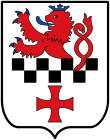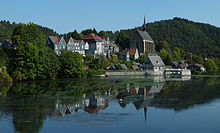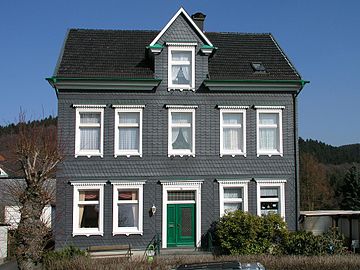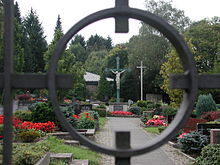Beyenburg
|
Beyenburg (87) district (as "Beyenburg-Mitte") of Wuppertal |
|
|---|---|
| Coordinates | 51 ° 15 ′ 0 ″ N , 7 ° 18 ′ 14 ″ E |
| height | 282 m above sea level NHN |
| surface | 2.66 km² |
| Residents | 3004 (December 31, 2016) |
| Population density | 1129 inhabitants / km² |
| Proportion of foreigners | 3.0% (December 31, 2016) |
| Post Code | 42399 |
| prefix | 0202 |
| structure | |
| Borough | Langerfeld-Beyenburg |
| Transport links | |
| bus | 586 616 626 669 NE8 |
| Source: Wuppertal statistics - spatial data | |
Beyenburg is a district on the Wupper in the east of Wuppertal . It has been part of the Langerfeld-Beyenburg district since 1975 and borders the Langerfeld district of Wuppertal and the towns of Schwelm , Ennepetal , Radevormwald and Remscheid .
In addition to the main town, the Beyenburg-Mitte residential area also includes the localities, suburbs and courtyards Beyenburger Lohmühle , Niederdahlhausen , Hengsten , In der Grüne , Mosblech , Scharpenstein , Siegelberg , Siepenplatz , Steinhaus , Sondern , Vor der Hardt and Zur Gute Hoffnung .
history
The historic town center lies in a loop of the Wupper river , which is dammed there in the Beyenburg reservoir . The latter was built in 1952–1953 as the successor to the Beyenburg compensation pond (built 1898–1900) by the Wupperverband to regulate the Wupper.
The historic town center in the Wupperschleife was first mentioned in 1303 as Beyenborch . Before 1296, Count Adolf V. von Berg († 1296) donated the nearby Oberhof Steinhaus and the associated chapel in favor of the Order of the Cross , which was demolished in 1811. In 1298 his brother Konrad I von Berg , formerly cathedral propst and archdeacon in Cologne , confirmed the gift of his deceased brother with the consent of his mother Margarete von Hochstaden . This confirmation certificate is the first written mention of the process.
The monastery was founded there soon after. Only a few years later (1303/04), the restless situation on the local Hanse and Heerstraße , the Heerweg Cologne – Dortmund , which was also a pilgrimage and travel route, prompted the Brothers of Cross to look for a new location downhill and that on the nearby Beyenberg to found a new Steinhaus monastery . A Wupper bridge on the Heerweg in Beyenburg was documented as early as 1339 .
The Oberhof Steinhaus itself, which is now also in the Beyenburg area, is older than the historic center. It was mentioned as early as 1189 when it was given as a pledge from the Counts of Berg to the Counts of Hückeswagen .
The most important building is the Beyenburg monastery church of St. Maria Magdalena , also called " Beyenburger Dom ", which was built in the 15th century . It was built with the monastery on the Beyenberg. In the church is the Kreuzkapelle, in which part of the relics of St. Odilia of Cologne , the patron saint of the Order of the Cross, are kept.
Beyenburg was the administrative center of the Bergisches Amt Beyenburg , founded in 1399 at the latest , to which the parishes of Lüttringhausen , Barmen , Radevormwald , Ronsdorf and Remlingrade belonged. Beyenburg Castle, first mentioned in 1336, was built next to the monastery as a protective castle, official seat of the bailiff and ducal residence , which today has fallen into disrepair except for a few retaining walls . Today's historic center of Beyenburg was built around the monastery and castle. Around 1400 it consisted of 26 houses and a water mill . As is customary for castle settlements in the Bergisches Land , the place was soon granted freedom , which, as a preliminary stage to a town, guaranteed certain privileges and independent jurisdiction.
The monastery was responsible for pastoral care, school education and poor relief. It was secularized in 1804 , served as a maternity ward under the care of the Augustinians during the Second World War until 1950, and was repossessed by the Order of the Cross in 1964 . Today (2008) it is the last monastery of this order in Germany. A stretch of the Rhenish Way of St. James from Dortmund via Cologne to Aachen stops at the monastery.
In 1797 70 inhabitants, 55 fireplaces, 38 Bergisch acres of arable land, 13 berg. Morning meadows, as well as 20 oxen and cows recorded.
In 1806 the ducal office of Beyenburg was dissolved by the French occupiers. After the transition to Prussia , Beyenburg was included in the newly created Lennep district in 1816 as part of the municipality of Lüttringhausen , in which it remained until 1929. This year Beyenburg was separated under the administrative reform of Luettringhausen and to Wuppertal umgemeindet .
In 1815/16 there were 523 people living in the village. Which according to the statistics and topography of the district of Dusseldorf as spots designated place was Beienburg called and had at that time a church, public building, 70 residential buildings, three factories or mills and two farm buildings. At that time there were 619 inhabitants, 119 Protestant and 500 Catholic. In the municipality lexicon for the Rhineland province from 1888, 108 houses with 1,044 inhabitants are given.
Street names still remind us of historically significant places. The street Steinhaus points to the former location of the Oberhof Steinhaus and its chapel. The former court court Mosblech , which followed Steinhaus, was located on Mosblech Street . The narrow footpath that connects the streets Steinhaus and Rentmeistersfeld is part of the former Hansestrasse ( Heerweg Cologne – Dortmund ) and is called " Sträßchen " by the Beyenburg residents . In the street treasurer field was treasurer , head of the Rent Office , resident. The street Porta Westfalica (gate to Westphalia) points to the earlier, great importance of the Beyenburger bridge as a border crossing, customs and control station.
- Beyenburg houses in the Bergisch style
Infrastructure
In 1888, Beyenburg was connected to the rail network by the Wuppertal Railway. The railway line has been closed since 1980, but is to be used again in the future as part of a museum railway operation.
The state roads L 411, L 414 and L 527 intersect in the village .
There are bus connections - sometimes very limited - in the direction of Wuppertal , Schwelm , Remscheid , Ennepetal and Radevormwald , all in all, Beyenburg is served by the following bus lines:
| line | Line course | cooperation | Cycle (Mon-Fri) | Clock (Sa) | Clock (Sun) | comment |
|---|---|---|---|---|---|---|
| 586 | Schwelm, Blücherplatz - W-Beyenburg Wupperbrücke - Schwelm, paper mill | VER | five trips a day | no operation | no operation | Only runs on school days |
| 616 | W-Oberbarmen Bahnhof - W-Beyenburg Mitte (- W-Beyenburg, Siegelberg )
|
20-40 min
(60 min) |
60 min | 60 min | ||
| 626 | W-Oberbarmen train station - W-Beyenburg center - Radevormwald, bus station
|
DB Rheinlandbus , OVAG | 30-60 min | 60 min | 60 min | |
| 659/669 | W-Beyenburg Mitte (669) - Radevormwald-Herkingrade (659) - Remscheid-Lennep, Grenzwall | Stadtwerke Remscheid | 20-120 min | 30-180 min | 60 min | |
| NE8 | W-Barmen Bahnhof - W-Oberbarmen Bahnhof - W-Beyenburg Mitte - W-Beyenburg Grünental - W-Oberbarmen Bahnhof - W-Barmen Bahnhof |
no operation | one trip a day | one trip a day |
Culture and sport
The oldest club in Beyenburg is the Schützenbruderschaft St. Annae et Katharinae Wuppertal-Beyenburg, which was founded in 1383. It is also one of the oldest in the Bergisches Land .
In 1900 the Bergischer Turnerbund Beyenburg 1900 eV, or BTB for short, was founded. It has the sports halls Am Kriegermal (opened on May 16, 1958) and Siegelberg (built in 1991) and the club house on Siegelberg (built in 1983).
Competitions in various water sports disciplines take place regularly on the Beyenburger reservoir .
Beyenburg is known in the field of youth culture for the Open Air Festival Beyenburg rocks , which took place three times from 2004 to 2006.
Municipal and other facilities
- There is a municipal primary school, which in 1976 moved from the house at Am Kriegermal 22 to a newly built school building at Siegelberg 40. In 2003 the building was demolished due to high levels of asbestos and in 2004 it was rebuilt in the same place. At the same time the school was Gemeinschaftsgrundschule Siegelsberg in elementary school Beyenburg renamed and now offers all-day care of.
- The police station, the city library and the citizens' office are now located in the former primary school building at Kriegermal.
- In addition to the SozialAKADEMIE Wuppertal eV, the Ita Wegman vocational college and the therapeutic residential community Porta eV are housed in the old Wuppertal-Beyenburg train station .
- At Kriegermal 50 there is a social therapeutic dormitory of the Blue Cross .
- There are three cemeteries in Beyenburg: the Catholic cemeteries “Zum Bilstein” and “Zum Steinhaus” and the Protestant cemetery “Am Kriegermal”.
- Right behind the last houses in Unterbeyenburg, across the Wupper in the Schemm area (Ennepetal), lies the Beyenburg chapel Maria Schnee . “I was a stable and wash house, I am a chapel, I greet hikers, I wish a blessing” can be read there as a motto on the wall. That explains the story. A small building in the midst of an invitingly landscaped area with a stone outer altar was converted into a chapel as part of a private initiative and is now in demand under the name of “Beyenburger Chapel Maria Schnee”, especially among pilgrims on the Way of St. The background is the “snow miracle” on one of the hills of Rome on the morning of August 5th, 358. The Madonna is said to have appeared to a Roman patrician named John and his wife and promised both that their wish for a son would be fulfilled if a church was built in her honor where there was snow the next morning. A replica of the miraculous image of Maria Schnee from Rome in a glass showcase next to a 51-armed candlestick determine the picture inside the small chapel on the Way of St. James .
societies
- Bergischer Turnerbund Beyenburg 1900
- Citizens and local history association Beyenburg
- DRC
- Community but
- Just life e. V.
- Porta e. V.
- Rifle brotherhood St. Annae et Katharinae
- TSV Beyenburg
Personalities
- Johannes Adolph Ibach (1766–1848), piano maker
- Martin Wilhelm von Mandt (1799-1858), surgeon, personal physician to Tsar Nicholas I.
- Ernst Schrupp (1915–2005), theologian, director of the mission house and the Wiedenest Bible School
- Bernd Sebastian Kamps (* 1954), doctor
- Harald Krassnitzer (* 1960), actor
- Ann-Kathrin Kramer (* 1966), actress
- Gerard Peter Vos (1926–2014), Father of the Order of the Cross, resident at Steinhaus Monastery from 1963 to 2014
literature
- Gerd Helbeck : Beyenburg - History of a place on the Bergisch-Mark border and its surrounding area (Volume I). The Middle Ages: Fundamentals and Advancement . 1st edition. Association for local history Schwelm, Schwelm 2007, ISBN 978-3-9811749-1-5 .
- Gerd Helbeck: Beyenburg - History of a place on the Bergisch-Mark border and its surrounding area (Volume II). The modern age: advances and setbacks . 1st edition. Association for local history Schwelm, Schwelm 2011, ISBN 978-3-9811749-2-2 .
- Hans Kadereit: Where there is still celebrations, reels and delights , a historical illustrated book Lüttringhausen, RGA-Buchverlag, 2009, ISBN 978-3-940491-07-7
Web links
- 700 years of the Kreuzherren in Beyenburg ( Memento from January 9, 2006 in the Internet Archive )
Individual evidence
- ^ Emil Pauls : A statistical table of the Duchy of Berg from 1797 . In: Bergischer Geschichtsverein (Hrsg.): Journal of the Bergisches Geschichtsverein . tape 39 . Elberfeld 1905, p. 180 f .
- ↑ Johann Georg von Viebahn : Statistics and Topography of the Administrative District of Düsseldorf , 1836
- ↑ Königliches Statistisches Bureau (Prussia) (Ed.): Community encyclopedia for the Rhineland Province, based on the materials of the census of December 1, 1885 and other official sources, (Community encyclopedia for the Kingdom of Prussia, Volume XII), Berlin 1888.
- ↑ Welcome to the community but in Wuppertal Beyenburg. Retrieved March 19, 2020 .












